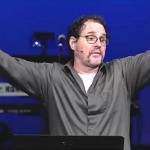We run our website the way we wished the whole internet worked: we provide high quality original content with no ads. We are funded solely by your direct support. Please consider supporting this project.
Was Noah’s flood global or local?
Though many regard the biblical story of a great flood in the days of Noah to be an ancient legend, evangelical Christians affirm it as historical fact because Scripture presents it as such. However, a debate has arisen during the last two hundred years as to whether the flood was global or local.
Those who defend the traditional position that the flood was global argue that the language used in the Genesis narrative requires this interpretation. For example, the narrative says, “All the high mountains under the whole heaven were covered” with water (Gen. 7:19). When one considers the height of the Himalayas or Mount Everest, they argue, it is clear that the flood was global. The Bible even names the mountain the ark came to rest on (Mount Ararat), and it alone is high enough to require a global flood (Gen. 8:4).
Defenders of the traditional view also point out that if the flood were only local, it would have been unnecessary for Noah to build a gigantic ark and house all species of animals for a year (Gen. 7:2–4). Not only this, but Scripture says the flood was intended to destroy all humanity. A local flood could not have accomplished this (Gen. 6:7, 13). Besides, the New Testament cites the flood episode as an example of the judgment upon the whole earth that is yet to come (2 Pet. 2:5).
Not all are convinced by these arguments, however. Some evangelicals argue that the language of the flood narrative may be interpreted phenomenologically (in terms of appearance) and hyperbolically (exaggeration for emphasis) rather than literally. In this case, the “high mountains” (7:19) that were covered by the flood may be understood as the hills in Noah’s region—probably the low-lying hills of Shinar or Babylon (cf. 11:2)—not as the miles-high mountains of the Himalayas. Moreover, there is no evidence that the mountain presently named Mount Ararat is the mountain referred to in Genesis, since this mountain received its name in recent times. Defenders of a local flood also argue that the purpose for the ark need not have been that there was no other way to save a remnant of animals or humans. It may have served as a warning for and witness against the generation that was to undergo judgment.
The main driving force behind the local flood theory, however, are the problems some find with the global flood theory. Local flood defenders customarily point to six major problems with the idea of a global flood:
1) Water high enough to cover the Himalayas and Mount Everest would have nowhere to run off. Yet the Bible describes the flood as abating with wind over several hundred days (Gen. 8:1).
2) A global flood in the recent past (within the past 10,000 years) would have left easily discernible evidence. Local flood defenders argue that while there is indisputable evidence for a mass local flood in the Mesopotamian region, there is no evidence for a global flood.
3) The mingling of freshwater and saltwater produced by a global flood would have killed all freshwater life. Yet freshwater life, including freshwater fish, still exists.
4) A blanket of water thick enough to cover all mountains would have destroyed dry land vegetation. If this was the case, where did the dove find a “freshly plucked olive leaf” (8:11)?
5) There is no way a pair of every species of animal could have traveled around the globe to the ark.
6) As large as the ark was, there is no way that tens of thousands of different species of animals could have fit on it—along with food sufficient to feed them (Gen. 6:21). Nor could this variety of animals have survived in closed quarters without sunlight for a year, according to local flood advocates.
I don’t have any resolved conviction about this debate. And though the difficulties the global flood perspective creates incline me toward the local flood view, I readily acknowledge this is not the easiest way to interpret the text. Two good books on this topic are R. Youngblood, ed., The Genesis Debate: Persistent Questions about Creation and the Flood (Thomas Nelson, 1986) and D. Young, The Biblical Flood: A Case Study of the Church’s Response to Extrabiblical Evidence (Eerdmans, 1995).
Category: Q&A
Tags: Bible, Old Testament, Q&A
Topics: Biblical Reliability
Related Reading

The God Who Embraces Our Doubt
Lawrence OP via Compfight Zack Hunt over at The American Jesus posted some of his thoughts on doubt, and it seemed fitting on this week before the Doubt, Faith & the Idol of Certainty conference to share what he had to say. We’re thinking he must have stumbled on Greg’s book or maybe God is…

What is the significance of Jeremiah 18:7–11?
The Lord states that “if that nation, concerning which I have spoken, turns from its evil, I will change my mind about the disaster that I intended to bring on it.” But if a nation which he has declared he will bless “does evil in my sight…I will change my mind about the good that…

How do you respond to Judges 9:23?
“…God sent an evil spirit between Abimelech and the lords of Schechem; and the lords of Shechem dealt treacherously with Abimelech.” (cf. 1 Sam. 16:14; 1 Kings 22:19–23). Some compatibilists cite this passage to support the view that evil spirits always carry out the Lord’s will (though they contend that God is good for willing…

Why Bart Ehrman Doesn’t Have to Ruin Your Christmas (Or Your Faith) Part 6
This is the sixth of several videos Greg put together to refute Bart Ehrman’s claims published in the article What Do We Really Know About Jesus? In this segment, Greg addresses the apparent discrepancies in the genealogies of Luke and Matthew and the implausibility of the idea that they were simply fabricated. We’ve been hearing that people are using…

Sermon: The Twist
In this sermon clip, Greg Boyd discusses how when you read a book with a twist ending, the ending reframes the entire story. The Bible is no different. In this sermon, Greg shows how Jesus’ message reframes how we are to understand the Bible, and he shows us why the Anabaptists shared this belief. You…

Is homosexual love without homoerotic behavior okay for a Christian?
Question: You may find this to be an odd question, but is it possible for two Christians of the same gender to remain a couple if they do not engage in sex? My partner and I love each other but our study of Scripture convinces us that having sex is wrong. Now, sex was never…
